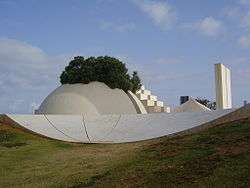Dani Karavan
| Dani Karavan | |
|---|---|
 Dani Karavan (1979) | |
| Native name | דני קרוון |
| Born |
Daniel Karavan 1930 Tel Aviv |
| Nationality | Israeli |
| Known for | sculpture |
| Movement | International style |
| Awards | Israel prize for sculpture Praemium Imperiale of Japan |
Daniel "Dani" Karavan (Hebrew: דני קרוון, born 1930) is an Israeli sculptor best known for site specific memorials and monuments which merge into the environment.
Biography

Daniel (Dani) Karavan was born in Tel Aviv. His father Abraham was the chief landscape architect of Tel Aviv from the 1940s to the 1960s.[1]
At the age of 13, he began studying painting. In 1943, he studied with Marcel Janco in Tel Aviv and from 1943-49 at the Bezalel School of Art in Jerusalem. After living on a kibbutz from 1948–55, he returned to art. From 1956-57, he studied fresco technique at the Accademia delle Belle Arti in Florence and drawing at the Académie de la Grande Chaumière in Paris.[1]
Art career
Karavan made permanent installations in the form of wall reliefs in Israeli courts and research institutions.[1] Examples of his artwork for courts are the 1966 Jerusalem City of Peace wall relief in the Knesset assembly hall and the environmental sculptures comprising 35 wall reliefs & iron sculpture made between 1962 and 1967 at the Court of Justice in Tel Aviv. For the Weizmann Institute of Science he made the From the Tree of Knowledge to the Tree of Life wall relief in 1964 and the Memorial to the Holocaust in 1972.
For performance groups he designed stage sets throughout the 1960s and 1970s. These included the Martha Graham Dance Company,[2] the Batsheva Dance Company, and the Israel Chamber Orchestra among others. After representing Israel with his Jerusalem City of Peace sculpture at the 1976 Venice Biennale, he obtained more international commissions - including sculptures in France, Germany, Japan, South Korea, Spain, and Switzerland.[1] One such project was a memorial entitled Passages for Walter Benjamin constructed between 1990 and 1994 in Portbou at the Spanish-French border in Spain where Walter Benjamin died in September 1940.
Karavan's advocacy of Tel Aviv's modern international style buildings encouraged their restoration and the inscription of The White City as a UNESCO World Heritage Site. Along with an exhibition about the city's architecture at the Tel Aviv Museum of Art in the mid-1980s, Karavan convinced mayor Shlomo Lahat to form a jury of international architecture and art critics to review these buildings. The value they placed on the city's town planning and design led to conservation in the 1990s and acceptance by UNESCO in 2003.[3]
Awards
- In 1977, Karavan was awarded the Israel Prize, for sculpture.[4][5]
- In 1998, he was one of five recipients of the Japanese annual Praemium Imperiale art prize.[6]
List of projects
- Negev memorial monument (1963–68, Beersheva)
- Memorial to the Holocaust, 1972, Weizmann Institute of Science, Rehovot, Israel.
- Kikar Levana (Hebrew for The White Plaza; 1977–88, Tel Aviv, Israel)
- Tower of Tears (memorial installation at Yad La-Shiryon, Latrun, West Bank)
- Axis of the Metropolis (1980-, Cergy-Pontoise, France)
- Tzaphon (iron sculpture in the form of a disc for the entrance square of the Landtag of North Rhine-Westphalia, Düsseldorf, Germany, 1990)
- The Way of Human Rights (1989–93, Germanisches Nationalmuseum, Nuremberg, Germany)
- Passage, a Homage to Walter Benjamin (1990–94, Portbou, Catalonia, Spain)
- Way to the Hidden Garden (1992–99, Sapporo Art Forest open-air gallery, Japan)
- Ma'ayan (1993–95, Miyazaki Prefecture Art Museum, Japan)
- Way of Peace (1996-2000, Negev Desert near Nitzana, Israel)
- Bereshit (Hebrew: Genesis; 2000-, Kirishima Art Forest, Kagoshima Prefecture, Japan)
- Regensburg Synagogue memorial, 2005
- Time (2009, Calenzano, Italy)
- Memorial to the Sinti and Roma victims of National Socialism (2012, Berlin, Germany)
See also
References
- 1 2 3 4 Pixel-Delight Dani Karavan website; accessed 4 January 2007.
- ↑ Moving force, Haaretz; accessed 18 November 2015.
- ↑ Yadin Roman. ERETZ: The Book (pg. 259), ERETZ Group. January 2005.
- ↑ Resources: Israeli Art Center. Karavan, Dani. The Israel Museum, Jerusalem. Accessed 9 October 2007.
- ↑ "Israel Prize Official Site - Recipients in 1977" (in Hebrew). Retrieved 17 November 2015.
- ↑ Praemium Imperiale. Dani Karavan 1998, sculpture, praemiumimperiale.org; accessed 9 October 2007.
Further reading
- Amnon Barzel, Luigi Lambertini, Pierre Restany: Dani Karavan: Un Ambiente Per La Pace / Environment for Peace (Biennale di Venezia, 1976, Israel) Firenze: Editrice Il Bisonte 1976
- Ursula Peters: Dani Karavan: Weg der Menschenrechte, in: Ursula Peters: Moderne Zeiten. Die Sammlung zum 20. Jahrhundert, in Zusammenarbeit mit Andrea Legde, Nürnberg 2000 (Kulturgeschichtliche Spaziergänge im Germanischen Nationalmuseum, Bd.3), S.274-281.
- Pierre Restany: Dani Karavan. Prestel, München (1992/1999); ISBN 3-7913-1211-1
- Udo Weilacher: "Harmonie und Zweifel - Dani Karavan" (Interview), in: Udo Weilacher: Zwischen Landschaftsarchitektur und Land Art. Basel Berlin Boston (1999); ISBN 3-7643-6120-4
- Udo Weilacher: "Weiße Erinnerung auf grünem Grund. Garten der Erinnerung in Duisburg von Dani Karavan", in: Udo Weilacher: In Gärten. Profile aktueller europäischer Landschaftsarchitektur. Basel Berlin Boston (2005); ISBN 3-7643-7084-X
External links
| Wikimedia Commons has media related to Dani Karavan. |
|